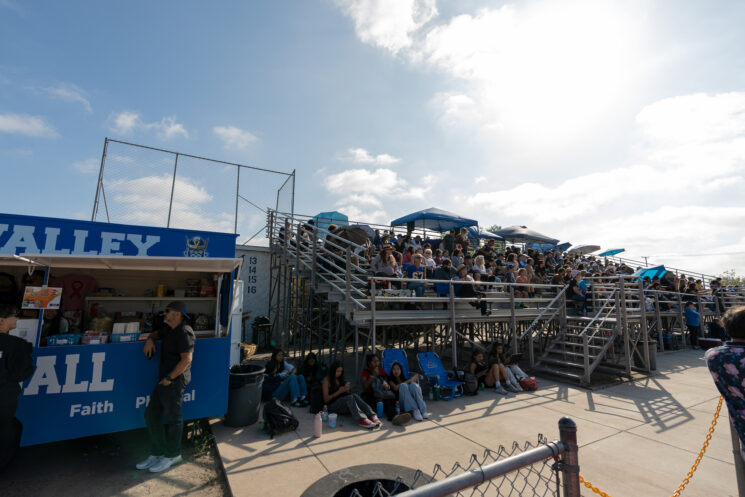
By Minh Ngoc Le
Stepping into the Friday night lights, Fountain Valley High School (FVHS) Barons are greeted with vibrant posters, lively music, and eager cheers as they settle in for the game. Smiles adorned with blue and gold, flashes of red pom-poms- but wait, those aren’t our logos!
Ever since the year 1966, the establishment of FVHS, home football games have been held at another school. Due to the lack of facilities and sub-standard-sized stadiums, the FVHS field is unable to support massive crowds, forcing them to borrow the fields of other schools within the district- most commonly Huntington Beach High School and Westminster High School.
The absence of a dedicated football stadium not only disrupts the sense of belonging and unity within the school community but also poses challenges for all Barons, especially football players, FVHS Pep Squad, and members of the Associate Student Body, to commute to different venues to immerse in the student culture.
While home games should be at home, existing conditions do not allow, inevitably causing the Barons to feel like visitors in their own Kingdom.
How did this come to be? Why does FVHS not have a standard-sized football field?
The lack of space to support a full-sized stadium has been a long-standing issue. With the school bordering a church property, a parking lot, and multiple tennis courts, there is limited space for further construction and would cost extensive facility modifications involving tearing down existing structures, which could potentially amount to millions of dollars.
Disruptance with surrounding residents also poses an obstacle, as intrusions and disturbances would cause an impact on the neighborhood. Environmental considerations regarding the school’s location above a water bed also serve as a challenge, as currently seen with the reconstruction of the pool.
“Once you break ground on a pretty project like that, things start happening,” Principle Paul Lopez said. “We had the water leakage, we’ve had our gas lines repaired… With the new ATA rules and the American Disabilities Act, bathrooms, plumbing, and all that stuff come into play. If we were to make that facility, we would have to reconfigure our baseball fields or reconfigure everything and just kind of switch gears.”
Though these challenges serve as an obstacle to all those involved, there are possible modifications to be made in order to improve the existing facility.
One such suggestion is to provide more lighting on the football field. Since many athletic teams hold practices after school hours, illuminating the field will provide better support for the athletes while avoiding potential injuries from happening at night. This modification will extend the usage of the area as well.
Another proposed idea is to turf the back soccer field. With more athletic participation with the addition of the girl’s flag football team, the turfing of the field could further accommodate the growing athletic interest at the school. While the existing facility covers a large area, it becomes unavailable during nighttime due to the lack of lighting; this expansion would provide additional space for athletic activities and events, especially during these hours when natural light is limited.
While the extension of the bleachers is also possible, the idea comes with its own set of challenges. If portable bleachers were to be brought to the other side of the field, portions of the track and the pole vaulting area would be cut off, posing an interference with the team’s practices. However, the idea is not impossible
“[It is] absolutely doable,” Principal Paul Lopez said.“We would have to come up with a plan for our Conex boxes for track and see what that would look like on the other side. We could work with the church to see if we could travel a little bit into the parking lot [in order to get enough space for the visiting teams.]
While not having a stadium has its posed difficulties, the Baron community remains resilient and supportive of their athletes. They have adapted to the situation, diligently coming out to enjoy the game at other schools and cheering on the football team every week.
“I think our school culture is getting better,” Lopez said. “I really appreciate what our students are doing and supporting our athletes; now it’s just spreading that wealth to our volleyball and basketball games and continuing that momentum.”
Some suggested activities for the upcoming year include having tailgate activities, grilling burgers, and setting up cornhole and bean bag games before walking in together. Hosting other teams’ ASBs and their administrations is a possibility as well.
Hopefully in the future, whether it is stadium construction or other improvements to the existing facilities, FVHS will continue to grow as a community that rallies together to support their teams and build upon their school culture.





